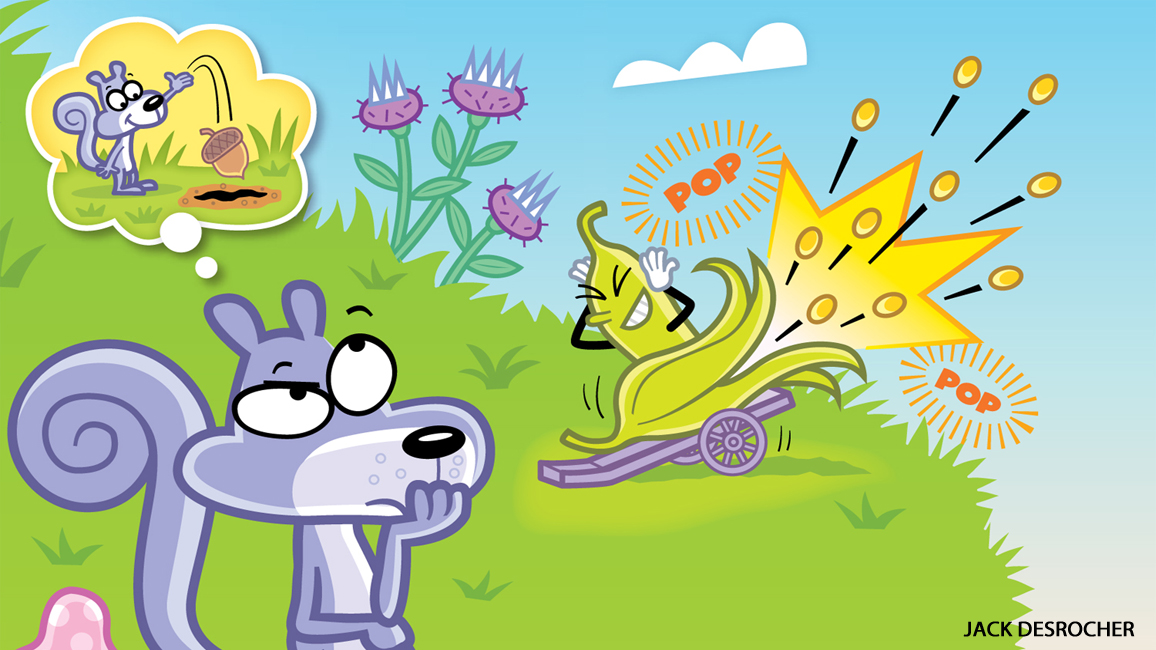
How do plants get to new places to grow? With help from bunches of seeds on the go!
 by Kate Hofmann; art by Jack Desrocher
by Kate Hofmann; art by Jack Desrocher
Seeds are travelers. They have their bags all packed with what they need to sprout in new places. Each one seeks only a patch of soil to call its own. But seeds don’t hop on a bus or a plane when it’s time to take the trip of a lifetime. Instead, their transportation is built right in. How many of these different kinds of seed travelers can you find?
FRUITY ONES
Sweet, colorful fruit is a tempting treat for birds and other animals. When an animal eats fruit, it also swallows the seeds inside. Later, it will poop the seeds out in a new place. Sometimes the droppings even work as fertilizer that helps the seeds grow.
Try this: Look on trees and shrubs for colorful berries or fruits. Open them up to find the seeds inside.
NUTTY ONES
 Squirrels spend lots of time collecting acorns and other nuts. Often a squirrel comes back for a nut it has buried, but sometimes it forgets—and then the lucky seed is already planted and ready to sprout!
Squirrels spend lots of time collecting acorns and other nuts. Often a squirrel comes back for a nut it has buried, but sometimes it forgets—and then the lucky seed is already planted and ready to sprout!
Try this: Find a tree full of nuts. Count how many squirrels are busy with the harvest. Are any burying nuts in the ground?
SHOOTERS
The small seeds of jewelweed, witch hazel, and violets grow inside little pods that squeeze them tight. When the time is right, the dry pods pop open—surprise!—and shoot the seeds through the air.
Try this: Touch one of these seedpods and, if it’s just-right ripe, watch the seeds fly!
WINGED WONDERS
A maple seed has a curved wing that spins like a helicopter blade as the seed falls to the ground. This helps the seed travel away from the tree where it grew. Elms, ashes, and other trees have seeds with wings, too.
Try this: Toss a winged seed up in the air and watch it whirl and twirl down. How far away does it land?
HITCHHIKERS
The seeds of burdock, sticktights, and certain other plants are called burs. Burs have tiny hooks that grab on to the fur of animals that pass by. This free ride may carry the seeds miles before they drop or the animal scratches them off.
Try this: Have burs come home stuck to you? Or to your dog? Use a magnifying glass for a close-up look at the tiny hooks of these hitchhikers.
FLOATERS
Water is almost always going somewhere. Seeds that float can bob all the way to a new home. Coconuts are famous for long-distance drifting, but many seeds use water to move.
Try this: Can you find a seed that floats? Toss it in some water and see if it works as a boat!
PARACHUTERS
Some seeds have fine, silky hairs. These hairs can catch a breeze and carry the seeds through the air. Dandelions, milkweeds, and other plants use these “parachutes” to drift—possibly for hours.
Try this: When you find a seed with a hairy parachute, huff, puff, and see if you can blow the seed far away!
Now that you’re in the know about seeds on the go, you’ll see seed travelers everywhere!



